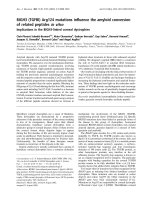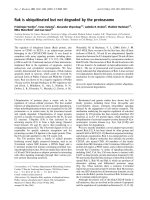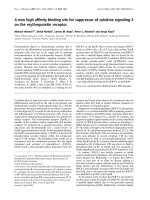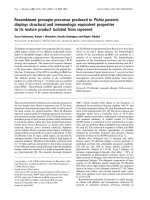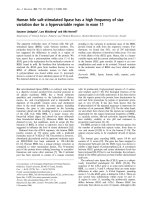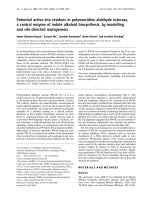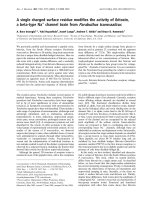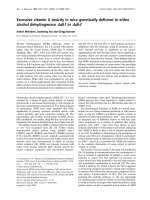Báo cáo y học: "IV among pregnant women in Moshi Tanzania: the role of sexual behavior, male partner characteristics and sexually transmitted infections" pot
Bạn đang xem bản rút gọn của tài liệu. Xem và tải ngay bản đầy đủ của tài liệu tại đây (295.32 KB, 10 trang )
BioMed Central
Page 1 of 10
(page number not for citation purposes)
AIDS Research and Therapy
Open Access
Research
HIV among pregnant women in Moshi Tanzania: the role of sexual
behavior, male partner characteristics and sexually transmitted
infections
Sia E Msuya*
1,2,3
, Elizabeth Mbizvo
1
, Akhtar Hussain
1
, Jacqueline Uriyo
1,3
,
NoelESam
3
and Babill Stray-Pedersen
2
Address:
1
Department of International Health, Institute of General Practice and Community Medicine, University of Oslo, Norway,
2
Department
of Obstetric and Gynaecology, Rikshospitalet University Hospital, University of Oslo, Norway and
3
Kilimanjaro Christian Medical Centre, P.O
Box 3010, Moshi, Tanzania
Email: Sia E Msuya* - ; Elizabeth Mbizvo - ;
Akhtar Hussain - ; Jacqueline Uriyo - ; Noel E Sam - ; Babill Stray-
Pedersen -
* Corresponding author
Abstract
Background: Women continue to be disproportionately affected by HIV in Tanzania, and factors
contributing to this situation need to be identified. The objective of this study was to determine
social, behavioral and biological risk factors of HIV infection among pregnant women in Moshi
urban, Tanzania. In 2002 – 2004, consenting women (N = 2654), attending primary health clinics
for routine antenatal care were interviewed, examined and biological samples collected for
diagnosis of HIV and other sexually transmitted/reproductive tract infections.
Results: The prevalence of HIV was 6.9%. The risk for HIV was greater among women whose male
partner; had other sexual partners (adjusted odds ratio [AOR], 15.11; 95% confidence interval [CI],
8.39–27.20), traveled frequently (AOR, 1.79; 95% CI, 1.22–2.65) or consumed alcohol daily (AOR,
1.68; 95% CI, 1.06–2.67). Other independent predictors of HIV were age, number of sex partners,
recent migration, and presence of bacterial vaginosis, genital ulcer, active syphilis and herpes
simplex virus type 2.
Conclusion: Development of programs that actively involve men in HIV prevention is important
in reducing transmission of HIV in this population. Further, interventions that focus on STI control,
the mobile population, sexual risk behavior and responsible alcohol use are required.
Background
The HIV epidemic continues to take its greatest toll in sub-
Saharan Africa, where more than 60% of the world's 40
million infected persons live [1]. Tanzania, a country with
a population of 34.5 million is among the worst affected,
having 7% of the adults infected with HIV [2]. There is a
diverse pattern of trends in HIV prevalence for different
geographical areas in the country. In some areas the
reports show a decreased trend in the prevalence and inci-
dence of HIV, especially among individuals aged 15–24
years [3,4]. In others, there is a gradual and continuing
spread of HIV [4,5]. In all areas however, women continue
Published: 17 October 2006
AIDS Research and Therapy 2006, 3:27 doi:10.1186/1742-6405-3-27
Received: 02 May 2006
Accepted: 17 October 2006
This article is available from: />© 2006 Msuya et al; licensee BioMed Central Ltd.
This is an Open Access article distributed under the terms of the Creative Commons Attribution License ( />),
which permits unrestricted use, distribution, and reproduction in any medium, provided the original work is properly cited.
AIDS Research and Therapy 2006, 3:27 />Page 2 of 10
(page number not for citation purposes)
to experience higher rates of prevalence and incidence
than men [2-5], and 58% of the HIV-infected in the whole
country are women [6]. There is therefore a need to eluci-
date risk factors continuing to contribute to the HIV epi-
demic among women of reproductive age.
In this study we report social, behavioral and biological
determinants for HIV, among pregnant women in Moshi
urban, Tanzania, including male partner's characteristics
and behavior. The study is part of a prospective cohort
study that aimed to describe the acceptability of HIV peri-
natal interventions at the primary health care level as well
as to determine factors associated with incident HIV and
sexually transmitted infections (STIs) in the postpartum
period. The information on determinants for HIV is
intended to contribute in improving counseling and in
planning for future preventive activities.
Results
Ninety nine percent of the 2664 women counseled agreed
to participate. Of the 2654 participating women, 99
agreed to undergo serological testing but declined gyneco-
logical examination. The age of the women ranged from
14–43 years (mean, 24.6 years, standard deviation = 5.4
years) and parity from 0–9 (mean, 1.2). Most were mar-
ried or cohabiting (91%), had completed 7 years of for-
mal education (79%) and were not formally employed
(95%). The average income per month was low; 29% had
no income and 65% had an income of less than 30,000
Tanzanian shillings or ~ 30 USD per month. The duration
of residence in Moshi ranged from less than a year to 42
years (mean, 12.7 years, median, 10 years). Condom use
was low; 75% reported they had never used a condom,
with only 13% reporting consistent use.
One hundred and eighty four women were HIV seroposi-
tive, giving a prevalence of 6.9% (95% CI, 5.9%–7.9%).
The prevalence of HIV increased from 2.8% among
women under 20 years to 10.1% in women aged 25–29
years and 8.5% among 35–39 year olds (P for trend
<0.001), see table 1. In the univariate analysis being sin-
gle, divorced or separated was more strongly associated
with HIV than being married (OR = 1.67), or being in a
polygamous relationship compared to those who were
not (OR 2.80). Women who consumed alcohol either
occasionally or daily had a higher HIV prevalence (OR
1.71) than those who did not. Recent migrants i.e. those
who had resided in Moshi for ≤2 years were more likely to
be HIV positive than long term residents (P for trend
0.009). Other covariates that significantly increased the
HIV risk in the univariate analysis were sexual debut at
≤15 years, perception of high risk for HIV and a higher
number of lifetime sexual partners (P for trend <0.001).
No association was found between HIV and religion,
employment, education level, income or report of fre-
quent traveling by the women.
Table 2 depicts the univariate analysis of woman's risk of
HIV in relation to male partner characteristics. The part-
ners were older by a mean of 6 years. Their age ranged
from 17–71 years (mean, 30.6 years, median, 30 years).
The risk for HIV in women increased as the partners age
increased, (P for trend <0.001). E.g. 9.5% of women with
partners aged 35–71 were HIV positive compared to 2.8%
in those whose partner were <25 years. Further, as the age
difference between couples increased to >10 years, so did
the likelihood of the women being HIV positive. Women
who were aware that their partners had women outside
the relationship had the greatest risk for HIV (OR 22.57).
Women were also more likely to be HIV infected if they
had partners who consumed alcohol (OR 1.71), traveled
frequently (OR 1.86), were involved in tourism or the
mining industry (OR 4.51), or verbally or physically
abused them (OR 1.66). Neither the partner's education
nor circumcision was associated with HIV infection.
A history of treatment for sexually transmitted infection
(STI) symptoms and the presence of laboratory confirmed
infection were strongly associated with HIV, table 3. The
presence of genital ulcers (P = 0.003), bacterial vaginosis
(P < 0.001), gonorrhoea (P = 0.03), active syphilis (P =
0.001), and herpes simplex type 2 (P = 0.003) increased
the risk for HIV in the univariate analysis.
In the multivariate analyses (table 4), the most significant
determinant for HIV was having a partner with women
outside the relationship [AOR = 15.11 (CI, 8.39–27.20)].
Other independent predictors of HIV were age ≥20 years,
sexual debut at ≤15 years, ≥2 lifetime sexual partners,
residing in Moshi ≤2 years, a male partner who consumed
alcohol daily, a partner who was away >4 times/month,
the presence of genital ulcer during examination, bacterial
vaginosis, active syphilis and HSV-2.
Discussion
Nearly 7% of the women in the study were HIV-positive,
indicating that HIV is still a major public health problem
among women of reproductive age in Moshi urban. The
prevalence observed (6.9%), is similar to the prevalence
of 7.3% described among women aged 15–49 years in
Kilimanjaro region, in the recent Tanzania HIV/AIDS
Indicator survey [2]. Given the high antenatal attendance
rates in the area (>97%), women attending antenatal
clinic can be used as a sentinel surveillance population in
monitoring trends of HIV infection among adults aged
15–49 years, despite its known limitations [1,7].
The HIV prevalence was greater among women who
started sex at an early age (≤15 years). The prevalence
AIDS Research and Therapy 2006, 3:27 />Page 3 of 10
(page number not for citation purposes)
peaked early at 10% among 25–29 year olds [2,5,8]. This
suggests that most infections in women occur at a younger
age, during the first few years after sexual debut [8]. Imma-
ture genital tract and cervical ectopy which is common in
young women might increase the risk [9,10]. Untreated
STIs may magnify the biological susceptibility [8,11]. Fur-
ther, because women tend to have older partners at debut
or later, they might be at higher risk because they might be
exposed to previously infected partners [8,12-14]. Preven-
tive programs should therefore target young people, espe-
Table 1: The association between HIV and sociodemographic, sexual behavior and risk perception among 2654 pregnant women in
Moshi Tanzania.
Predictor N (%) % HIV
positive
Unadjusted OR (95% CI) P value
Age (completed years)
14 – 19 471 (17.7) 2.8 1
20 – 24 996 (37.5) 5.9 2.22 1.20 – 4.09 0.01
25 – 29 664 (25.0) 10.1 3.95 2.16 – 7.25 <0.001
30 – 34 382 (14.4) 9.2 3.55 1.85 – 6.82 <0.001
35 – 39 117 (4.4) 8.5 3.29 1.41 – 7.71 0.006
40 + 24 (0.9) 0.0 - -
Years of residence in Moshi
3 + 2095 (78.9) 6.4 1
1 – 2 years 391 (14.7) 7.7 1.22 0.81 – 1.84 0.35
<1 year 168 (6.3) 11.9 1.98 1.20 – 3.26 0.007
Alcohol consumption
No 1833 (69.1) 5.8 1
Occasionally/weekly 770 (29.0) 9.2 1.66 1.21 – 2.26 0.002
Daily 51 (1.9) 13.7 2.59 1.14 – 5.89 0.02
Marital status
Married 1624 (61.2) 6.0 1
Cohabiting 790 (29.8) 8.1 1.39 1.00 – 1.93 0.05
Single/separated/divorced 240 (9.1) 9.6 1.67 1.04 – 2.69 0.04
Polygamy relationship †
No 2245 (84.6) 6.0 1
Yes 296 (11.2) 15.2 2.80 1.95 – 4.02 <0.001
Number of pregnancies
1
st
pregnancy 968 (36.4) 3.5 1
2
nd
pregnancy 700 (26.4) 9.0 2.72 1.77 – 4.17 <0.001
3
rd
or more 986 (37.1) 8.8 2.66 1.17 – 3.99 <0.001
Age at first sex (years)
19 + 1068 (40.2) 5.7 1
16 – 18 years 1208 (45.5) 7.0 1.25 0.89 – 1.76 0.19
9 – 15 years 378 (14.2) 10.1 1.85 1.21 – 2.82 0.005
Number of lifetime sexual partners
1 1490 (56.1) 2.3 1
2 834 (31.4) 9.8 4.53 3.02 – 6.79 <0.001
3 237 (8.9) 17.7 8.95 5.58 – 14.37 <0.001
4 + 93 (3.5) 26.9 15.28 8.66 – 26.97 <0.001
Casual partner in the past 12 months
No 2537 (95.6) 6.7 1
Yes 117 (4.4) 11.1 1.73 0.95 – 3.14 0.07
Ever used a condom
No 1984 (74.8) 6.0 1
Yes 670 (25.2) 9.7 1.68 1.23–2.31 0.001
Perceived risk of HIV infection
No risk 891 (33.6) 5.6 1
Small risk 1006 (37.9) 7.4 1.34 0.92 – 1.94 0.13
Moderate risk 119 (4.5) 10.1 1.89 0.97 – 3.66 0.06
High risk 45 (1.7) 17.8 3.64 1.61 – 8.22 0.002
Don't know 593 (22.3) 6.7 1.22 0.79 – 1.87 0.37
†
113 women excluded because currently they do not have a steady partner
AIDS Research and Therapy 2006, 3:27 />Page 4 of 10
(page number not for citation purposes)
cially women, with the aim to empower them to delay
sexual debut and to improve their negotiating skills, espe-
cially regarding condom use.
Male factors were strong predictors for HIV. Having a part-
ner who had other women outside the relationship
increased the HIV risk by 15-fold. Alcohol use by the part-
ner also increased the HIV risk. The better economic and
cultural position of men compared to women in most
African settings leads to a skewed balance of power in sex-
ual relationships [12-15]. Men are thus the main decision
makers of when and under what circumstances sex will
take place [12,15,16]. Several reports show that married
men report more casual partnerships than married
women [8,12,13], and when they use alcohol, they have
increased risk of unprotected sex and commercial sex [17].
However, due to women's lower social and cultural posi-
tion than men, women's economic dependence, and
domestic violence, most are not in a position to negotiate
safe sex [12,15,16,18]. In this study women who gave a
history of physical or verbal abuse by the current partner
had both an increased risk of HIV and of not coming back
for their HIV test results [18,19]. It is thus vital to design
programs that actively involve men in HIV preventive
interventions and in other reproductive health issues. The
focus of preventive efforts should be to encourage men to
use condoms consistently in any sexual encounter with a
person of unknown HIV status and reduce the numbers of
sexual partners. There is also a need to promote the use of
voluntary counseling and testing services as a preventive
tool especially for people entering into stable partner-
ships. Further, culturally sensitive interventions that
Table 2: Predictors for HIV infection among pregnant women in Moshi, Tanzaniain relation to male partners characteristics
Predictor N (%) % HIV
positive
Unadjusted OR (95% CI) P value
Partners age (years)
¶
<25 464 (17.5) 2.8 1
25–34 1425 (53.7) 6.5 2.42 1.34 – 4.37 0.003
35–71 677 (25.5) 9.5 3.62 1.97 – 6.66 <0.001
Age difference (male – female) in years
¶
0 91 (3.4) 5.5 1
-
11 –
-
1 81 (3.1) 8.6 1.63 0.49 – 5.34 0.42
1 – 10 2047 (77.1) 5.8 1.05 0.42 – 2.64 0.91
11 – 41 347 (13.1) 11.5 2.24 0.86 – 5.85 0.09
Partner has other women outside the relationship †
No 944 (35.6) 2.3 1
Yes 200 (7.5) 35.0 22.57 13.51–37.69 <0.001
Do not know 1397 (52.6) 6.3 2.82 1.75 – 4.53 <0.001
Partner consumes alcohol
No 1239 (51.3) 5.5 1
Occasionally/weekly 763 (31.6) 7.6 1.42 0.99 – 2.04 0.06
Daily 411 (17.0) 11.7 2.28 1.55 – 3.36 <0.001
No response 241 (9.1) 4.1 0.75 0.38 – 1.47 0.39
Partner travel frequently (≥4 times/month)
No 1794 (74.3) 6.0 1
Yes 619 (25.7) 10.7 1.86 1.35 – 2.57 <0.001
No response 241 (9.1) 4.1 0.68 0.35 – 1.311 0.25
Partner's occupation
Professional 81 (3.1) 4.9 1
Driver 282 (10.6) 6.4 1.31 0.43 – 3.99 0.63
Army/police force/security guard 265 (10.0) 12.1 2.64 0.91 – 7.71 0.07
Tour guide/miner 58 (2.2) 19.0 4.51 1.36 – 14.97 0.02
Others
#
828 (74.2) 6.0 1.24 0.45 – 3.44 0.68
Verbal or physical abuse by partner
No 2062 (77.7) 6.6 1
Yes 351 (13.2) 10.5 1.66 1.13 – 2.43 0.01
No response 241 (9.1) 4.1 0.61 0.32 – 1.17 0.14
Partner as 1
st
person wished to share HIV results with
Yes 2390 (90.1) 6.1 1
No 264 (9.9) 14.4 2.58 1.76 – 3.79 <0.001
¶ 88 women excluded because they do not know their partners age.
† 113 women excluded because currently they do not have a steady partner.
# Farmer, trader, technical and unskilled labor
AIDS Research and Therapy 2006, 3:27 />Page 5 of 10
(page number not for citation purposes)
address domestic violence should be integrated in HIV
preventive programs [15,16,18].
Women with partners who were mobile (i.e. frequent
travelers, or involved in tourism or the mining industry)
had a higher HIV prevalence. Mobile men have been
shown to report more sexual risk behavior, (e.g. multiple
partners, excess alcohol intake and sex with commercial
sex workers), putting them and consequently their part-
ners at risk of HIV [20]. It may also be that women with
absent partners are more likely to engage in casual part-
nerships because they are either free, lonely, or experience
economic hardship. Recently, a study among couples in
Mwanza, Tanzania, showed that there is an increase of
sexual risk behavior in both the mobile person and the
partner staying behind [21]. Further work is required to
assess the vulnerability of this special group of women
who are partners of mobile men and preventive efforts
extended to both the mobile partners and their women.
A higher HIV prevalence was observed in women who had
recently migrated into Moshi (≤2 years). Compared to
women who had resided in Moshi for >3 years, they were
younger than 25 years (78% vs 49%; p = < 0.001), had no
or incomplete primary education (14% vs 10%; p =
0.006), had no income (39% vs 26%; p < 0.001), reported
more casual partners in the past 12 months (8.3% vs
4.1%; p = 0.01) and had more GUD (2.6% vs 1.3%; p =
0.04). It may be that most of these women, who had
moved to an urban area to seek a better life, had to engage
in high risk behavior in order to survive, as shown in
South Africa [22]. Mobility and internal migration seems
to be an important character of the HIV epidemic in
Moshi. Long term programs that will identify migrant
women and promote safer sex and economic empower-
ment are required.
Genital ulcer, active syphilis and HSV-2 were independent
risk factors for HIV. STIs increase the efficiency of HIV
Table 3: The association between HIV-1 with genital symptoms, clinical signs and sexually transmitted infections among pregnant
women in Moshi Tanzania.
Predictor N (%) % HIV
positive
Unadjusted OR (95% CI) P value
Treatment for STI symptoms in past 12 months
¶
No 1969 (74.2) 5.9 1
Yes 685 (25.8) 9.8 1.72 1.25 – 2.35 0.001
Report abnormal vaginal discharge or itch at interview
No 2200 (82.9) 6.1 1
Yes 454 (17.1) 10.8 1.85 1.31 – 2.61 <0.001
Genital ulcer on examination*
No 2514 (94.7) 7.0 1
Yes 41 (1.5) 19.5 3.24 1.47 – 7.12 0.003
Bacterial vaginosis*
No 2022 (76.2) 5.7 1
Yes 533 (20.1) 12.8 2.43 1.77 – 3.33 <0.001
Trichomoniasis*
No 2428 (91.5) 7.0 1
Yes 127 (4.8) 10.2 1.52 0.84 – 2.75 0.171
Candidiasis*
No 2264 (85.3) 6.9 1
Yes 291 (11.0) 8.9 1.32 0.85 – 2.03 0.214
Gonococcal infection (GND)*
No 2542 (95.8) 7.1 1
Yes 13 (0.5) 23.1 3.94 1.07 – 14.43 0.04
Active syphilis
No 2631 (99.1) 6.8 1
Yes 23 (0.9) 26.1 4.86 1.89 – 12.49 0.001
Herpes simplex virus type 2
†
No 844 (31.8) 12.3 1
Yes 427 (16.1) 18.5 1.62 1.17 – 2.22 0.003
GND = Intracellular gram-negative diplococci on cervical smear.
¶
Vaginal discharge, genital itch, genital ulcer, dysuria, dyspareunia.
*Missing values because 99 women were not examined and/or samples not provided.
†
Test done on 1271 women only
AIDS Research and Therapy 2006, 3:27 />Page 6 of 10
(page number not for citation purposes)
transmission [11]. Genital ulcers increase the HIV suscep-
tibility by disruption of the mucosa barrier, thus provid-
ing an easy port of entry and increase the recruitment and
activation of HIV susceptible inflammatory cells. The
inflammation and ulceration increases HIV shedding in
the genital tract, thus the HIV infectiousness [10,11]. HSV-
2 and syphilis are ulcerative STIs, and are highly prevalent
among women in resource poor settings [8,22-24]. Effec-
tive management of STIs reduces the HIV incidence [25],
therefore STI control should be prioritized. One strategy
for reaching more women will be an integration of STI
management in reproductive health clinics. Further,
Table 4: Multivariate analyses of predictors for HIV infection among pregnant women in Moshi Tanzania.
Predictor Adjusted OR (95% CI)
†
P value
Age (years)
14 – 19 1
20 – 24 2.45 (1.19 – 5.07) 0.015
25 – 29 4.77 (2.27 – 10.03) <0.001
30 – 34 3.92 (1.74 – 8.86) 0.001
35 – 39 3.73 (1.29 – 10.81) 0.02
Years of residence in Moshi
3 + 1
1 – 2 years 2.23 (1.36 – 3.66) 0.002
<year 2.49 (1.26 – 4.91) 0.008
Number of lifetime partners
11
2 3.29 (2.10 – 5.17) <0.001
3 4.08 (2.33 – 7.14) <0.001
4 or more 6.11 (2.97 – 12.57) <0.001
Age at first sex (years)
19 + 1
9 – 15 years 1.81 (1.06 – 3.11) 0.03
Partner has women outside the relationship
No 1
Don't know 2.70 (1.60 – 4.57) 0.001
Yes 15.11 (8.39 – 27.20) <0.001
Partner consumes alcohol
No 1
Daily 1.70 (1.06 – 2.67) 0.03
Partner travel frequently (≥4 times/month)
No 1
Yes 1.79 (1.22 – 2.65) 0.003
Partner's occupation
Professional 1
Army/police/security guard 2.56 (0.62 – 10.57) 0.19
Tour guide/miner 3.02 (0.79 – 15.11) 0.11
Partner as 1
st
person wished to share HIV results with
Yes 1
No 1.71 (1.03 – 2.84) 0.04
Genital ulcer at examination
No 1
Yes 2.92 (1.07 – 7.94) 0.03
Bacterial vaginosis
No 1
Yes 2.00 (1.36 – 2.95) <0.001
Active syphilis
No 1
Yes 4.41 (1.22 – 15.95) 0.02
HSV-2
¶
No 1
Yes 1.36 (1.01 – 1.98) 0.04
†
Adjusted for all the variables in the table plus marital status, polygamy, number of pregnancies, history of STIs, report of vaginal discharge/itch and
male partners age and report of verbal or physical abuse.
¶
Adjusted for all the variables in the table
AIDS Research and Therapy 2006, 3:27 />Page 7 of 10
(page number not for citation purposes)
because a growing number of ulcers are caused by HSV-2
[26], its management should be integrated in the GUD
syndromic guidelines in Tanzania. Bacterial vaginosis has
been shown to be strongly associated with HIV [27]. It is
known to be the most common cause of vaginal discharge
and consistent correlation between the symptom of vagi-
nal discharge and BV warrants the use of a syndromic
approach for timely treatment of this infection [11,27].
Prompt treatment will reduce not only the risk of HIV
transmission, but also the adverse obstetric and gyneco-
logical complications associated with BV [11,27,28].
Sporadic use of condoms did not confer protection to
HIV, similar to what was observed elsewhere [13,29].
Condoms are effective when used correctly and consist-
ently. Consistent condom use was low among the
women. It may also be that people who know or suspect
they have HIV may tend to use condoms more to protect
their partners. Or condom use may be a marker of high
risk sexual behavior as shown in one study, where people
with multiple partners reported higher rates of use of con-
doms than those with a single partner [29].
This study had several limitations. This was a cross-sec-
tional study, so the odds ratios observed may overesti-
mate risk estimates and the associations may not be
causal. Secondly, sensitive information regarding the
male partner's behavior characteristics was reported by the
women. The accuracy may be low due to lack of openness
regarding sexual matters between the partners, and prob-
ably some degree of guesswork regarding casual partners.
Limitation in self-reported data on sexual behavior has
been shown, where there is a tendency to under report
sexual risk behavior [8,13]. The results observed in this
data may thus be an underestimation of the true associa-
tion between HIV and behavior characteristics. HIV
decreases fertility in women, both from sub fertility and
from increased early pregnancy loss [30]. HIV infected
women also have higher rates of tubal infertility second-
ary to pelvic inflammatory diseases [31], therefore the
prevalence presented might fail to reflect those who are
not able to become pregnant. Lastly, women aged ≥35
years were few (5.3%) in the antenatal clinic, therefore the
prevalence might not reflect the picture among women of
that age in the community [32].
Conclusion
HIV is still a major health problem among women of
reproductive age. The behavior and other characteristics of
the male partners in this study were important predictors
for HIV in women. Therefore, involvement of men in HIV
prevention and in all aspects of reproductive health pro-
grams is of the utmost importance if we want to make
advances in preventing HIV in women and in the commu-
nity at large. Empowering women with the skills and
rights to negotiate in sexual matters must be more success-
fully addressed. Other important preventive strategies
should aim at control of STIs, reduction of number of
partners, increased use of condoms in long term partner-
ships, responsible alcohol use and targeting mobile peo-
ple.
Methods
Study area, population and study procedures
Moshi urban district is situated in Northern Tanzania, and
is one of 6 districts in Kilimanjaro region. It is the capital
of the region and has a population of about 230,000 peo-
ple. Most people are employed in the private sector and
the main income generating activities are tourism, trading
and agriculture.
The present study was conducted in the two largest pri-
mary health care clinics, Majengo and Pasua. These clinics
were selected because they have the largest number of
patients and represent women from the largest geograph-
ical areas (administrative wards). Pregnant women
attending the clinics for routine care, who were in their 3
rd
trimester and residing in Moshi urban, were eligible to
participate. They were informed about the study and its
aims, and were invited to participate between June 2002
and March 2004. Women wishing to participate in the
study signed a written informed consent. For illiterate
women the right thumb print was taken as a signature.
Trained research nurses conducted individual pretest
counseling of every woman. The women were assured that
the information they provided and test results would be
treated confidentially and that participation in the study
was voluntary. They could withdraw from participation or
follow-up at any time and this would not affect their pre-
natal care or access to other services at the clinic. Ten
women refused to participate after the pretest session
while 2654 women agreed to participate. Interviews were
then conducted in a private room to obtain information
on socio-demographic variables, sexual behavior, obstet-
ric history, perceived risk of HIV, alcohol use and on cur-
rent and past sexually transmitted infection (STI)
symptoms, by using a standardized pre-tested question-
naire. Detailed information regarding the male partner's
demographic and behavioral factors, alcohol use and
communication between couples was collected. The inter-
views were conducted in Kiswahili, the national language.
After the interview, a general and gynecological examina-
tion was performed. Genital ulcers, warts and abnormal
vaginal discharge were diagnosed clinically during the
examination. Vaginal secretions were collected for meas-
uring pH level, whiff test, for Gram-staining and identifi-
cation of Trichomonas vaginalis, and Candida species. An
endocervical swab was collected for Gram-staining and
AIDS Research and Therapy 2006, 3:27 />Page 8 of 10
(page number not for citation purposes)
identification of Neisseria gonorrhea. Genital samples were
not collected from 99 (4%) of the women because they
did not want to undergo speculum examination. Venous
blood was collected for serological analysis of HIV, syph-
ilis and herpes simplex virus type 2. The women were
assigned numeric identifiers and all the questionnaires,
follow-up forms and laboratory samples were labeled
with matching numbers to maintain confidentiality.
The women were asked to return for their HIV/STIs results
in one week. Post-test counseling was conducted individ-
ually with each woman, where possible by the same nurse
who conducted the pre-test counseling. HIV positive
women were given a single dose of Nevirapine (tablet) to
take at the onset of labor and they were instructed to bring
their children within 72 hours after delivery to receive the
Nevirapine syrup. This regimen was for prevention of
mother-to-child transmission (PMTCT) of HIV according
to the HIVNET 012 regimen [33]. Genital infections diag-
nosed during clinical examination were treated syndromi-
cally based on the Tanzanian Ministry of Health
guidelines. Laboratory confirmed infections were treated
a week later, during the post test visit. All women were
encouraged to inform their partners and bring them for
counseling and testing, and those with proven sexually
transmitted infections were given a contact card to give to
their partners so that they could come for treatment. All
the services were free of charge for both the women and
their partners. At the time the study was conducted, there
was no routine service for counseling and testing of preg-
nant women for HIV, nor was there a PMTCT program.
Permission for the study was obtained from the Tanza-
nian Ministry of Health and the Norwegian Ethical Com-
mittee.
Laboratory procedures
Except for HSV-2 testing, which was performed at the lab-
oratory at KCMC referral hospital, all other tests were per-
formed at the clinics. Within 6 hours of collection, blood
was centrifuged on site and serum was tested for HIV by
using two rapid tests, Determine HIV 1/2 (Abbott Labora-
tories, IL, USA) and Capillus HIV1/2 (Trinity Biotech, Ire-
land). HIV was diagnosed when both the test results were
positive. In case of discordance between the two tests, a
third test, the ELISA test, Vironostika HIV Uni-form II
(Organon Teknika, Boxtel, Netherlands) was used. Seven
samples were discordant by the rapid tests. Three of the
seven samples tested positive by the third test and were
diagnosed positive, the remaining four were negative.
Active syphilis was diagnosed by positive results of both
the rapid plasma reagin test (RPR; Becton Dickinson, MD,
USA) and a specific test, Determine Syphilis TP (Abbott
Laboratories, IL, USA). HSV-2 was detected by the type-
specific HSV-2 ELISA (Focus Diagnostics, Cypress, Califor-
nia USA).
A wet mount of the vaginal swab was prepared in normal
saline for microscopic identification of motile Tri-
chomonas vaginalis, yeast cells and for presence of clue
cells. Direct microscopy was done on Gram-stained geni-
tal swabs for the detection of leucocytes, Candida species
and gram-negative diplococci. The diagnosis of bacterial
vaginosis was made according to the Amsel criteria [34].
Candidiasis was diagnosed by visualization of Candida
species on wet mount or gram-stained vaginal swabs.
Statistical analysis
The data were analyzed using SPSS statistical software,
version 10.0 (SPSS, Chicago, IL, USA). Statistical compar-
ison between groups was made using χ
2
and odds ratios
(OR) were calculated with a 95% confidence interval (CI)
to measure the strength of association between potential
predictor factors and HIV. Multiple logistic regression was
executed to adjust for potential confounders. Variables
were entered in the models based on the level of signifi-
cance in the univariate analyses at P < 0.20 or if they were
known to be important risk factors for HIV based on pre-
vious reports. Stepwise procedure using an automated
backward selection model was used to determine a final
model. The level of significance was set at P ≤ 0.05.
Abbreviations
STIs: sexually transmitted infections
HSV-2: herpes simplex virus type 2
GUD: genital ulcer disease
PMTCT: prevention of mother-to-child transmission of
HIV
OR: odds ratio
CI: confidence interval
Competing interests
The author(s) declare that they have no competing inter-
ests.
Authors' contributions
SEM: Designed the study, coordinated recruitment of
patients, collected and entered data, analyzed data and
drafted the manuscript.
EM: Designed the study, participated in data analysis, and
reviewed the drafted manuscript.
AH: Designed the study, interpreted and analyzed the
data, reviewed the drafted manuscript.
AIDS Research and Therapy 2006, 3:27 />Page 9 of 10
(page number not for citation purposes)
JU: Participated in data collection, laboratory testing and
data analysis, also reviewed the drafted manuscript.
NES: Designed the study, supervised laboratory testing,
reviewed the drafted manuscript.
BSP: Designed and coordinated the study, interpreted the
data, reviewed the drafted manuscript.
All the authors read and approved the final manuscript.
Acknowledgements
We thank the mothers who participated. The authors also thank the Tan-
zanian Ministry of Health and the Regional and District Medical Officers for
allowing the study to be conducted, the team of nurses and laboratory staff
at Majengo and Pasua clinics for their hard work, and Robert K Stallman for
review of the manuscript. This study was supported by a grant from the
Letten Saugstad Foundation.
References
1. United Nations Program on HIV/AIDS (UNAIDS)/World Health
Organization (WHO): AIDS epidemic update, December 2005.
UNAIDS/WHO, Geneva, Switzerland; 2005.
2. Tanzania Commission for AIDS (TACAIDS), National Bureau of Sta-
tistics (NBS), and ORC Macro: Tanzania HIV/AIDS Indicator Sur-
vey 2003-04. Calverton, Maryland, USA: TACAIDS, NBS, and ORC
Macro; 2005.
3. Kwesigabo G, Killewo J, Urassa W, Lugalla J, Emmelin M, Mutembei
A, Mhalu F, Biberfeld G, Wall S, Sandstrom A: HIV-1 infection
prevalence and incidence trends in areas of contrasting lev-
els of infection in the Kagera region, Tanzania, 1987–2000. J
Acquir Immune Defic Syndr 2005, 40(5):585-591.
4. Jordan-Harder B, Maboko L, Mmbando D, Riedner G, Nagele E,
Harder J, Kuchen V, Kilian A, Korte F, Sonnenburg F: Thirteen
years HIV-1 sentinel surveillance and indicators for behav-
ioural change suggest impact of programme activities in
south-west Tanzania. AIDS 2004, 18:287-294.
5. Mwaluko G, Urassa M, Isingo R, Zaba B, Boerma JT: Trends in HIV
and sexual behaviour in a longitudinal study in a rural popu-
lation in Tanzania, 1994–2000. AIDS 2003, 17(18):2645-2651.
6. Ministry of Health Tanzania Mainland: National AIDS Control
Program HIV/AIDS/STD Surveillance Report No 18. Dar es
Salaam, Africa: Tanzania Ministry of Health; 2004.
7. Kwesigabo G, Killewo J, Urassa W, Mbena E, Mhalu F, Lugalla J, Godoy
C, Biberfeld G, Emmelin M, Wall S, Sandstrom A: Monitoring of
HIV-1 infection prevalence and trends in the general popula-
tion using pregnant women as a sentinel population: 9 years
experience from the Kagera region of Tanzania. J Acquir
Immune Defic Syndr 2000, 23:410-417.
8. Glyn JR, Carael M, Auvert B, Kahindo M, Chege J, Musonda R, Kaona
F, Buve A, and the study group on the heterogenicity of HIV epidem-
ics in African cities: Why do young women have a much higher
prevalence of HIV than young men? A study in Kisumu,
Kenya and Ndola, Zambia. AIDS 2001, 15(Suppl 4):S51-S60.
9. Royce RA, Sena A, Cates W, Cohen MS: Sexual transmission of
HIV. N Engl J Med 1997, 336:1072-1078.
10. Plourde PJ, Pepin J, Agoki E, Ronald A, Ombette J, Tyndall M, Cheang
M, Ndinya-Achola J, D'Costa LJ: Human immunodeficiency virus
type 1 seroconversion in women with genital ulcers. J Infect
Dis 1994, 170:313-317.
11. Fleming D, Wasserheit J: From epidemiological synergy to pub-
lichealth policy and practice: the contribution of other sexu-
ally transmitted diseases to sexual transmission of HIV
infection. Sex Transm Infect 1999, 75:3-17.
12. Macumbi P, Amaral E: Reproductive rights and HIV/AIDS. Best
Pract Res Clin Obstet Gynaecol 2006 [.
].
Accessed 26 April 2006.
13. Gregson S, Nyamukapa CA, Garnett GP, Mason PR, Zhuwau T,
Carael M, Chandiwana SK, Anderson RM: Sexual mixing patterns
and sex-differentials in teenage exposure to HIV infection in
rural Zimbabwe. Lancet 2002, 359:1896-1903.
14. Laga M, Schwartlander B, Pisani E, Sow PS, Carael M: To stem HIV
in Africa, prevent transmission to young women. AIDS 2001,
15(7):931-934.
15. Gupta GR: How men's power over women fuels the HIV epi-
demic. BMJ 2002, 324(7331):183-184.
16. Langen TT: Gender power imbalance on women's capacity to
negotiate self-protection against HIV/AIDS in Botswana and
South Africa. Afr Health Sci 2005, 5(3):188-197.
17. Lewis JJ, Garnet GP, Mhlanga S, Nyamukapa CA, Donnelly CA, Greg-
son S: Beer halls as a focus for HIV prevention activities in
rural Zimbabwe. Sex Transm Dis 2005, 32(6):364-369.
18. Kiarie J, Farquhar C, Richardson B, Kabura M, John F, Nduati R, John-
Stewart G: Domestic violence and prevention of mother-to-
child transmission of HIV-1. AIDS 2006, 20:1763-1769.
19. Msuya S, Mbizvo E, Uriyo J, Stray-Pedersen B, Sam NE, Hussain A:
Predictors of failure to return for HIV test results among
pregnant women in Moshi, Tanzania. J Acquir Immune Defic
Syndr 2006, 43(1):85-90.
20. Mbizvo MT, Machekano R, McFarland W, Ray S, Basset M, Latif A,
Katzenstein D: HIV seroincidence and correlates of serocon-
version in a cohort of male factory workers in Harare, Zim-
babwe. AIDS 1996, 10:895-901.
21. Kishamawe C, Vissers D, Urassa M, Isingo R, Mwaluko G, Borsboom
G, Voeten H, Zaba B, Habbema D, de Vlas S: Mobility and HIV in
Tanzanian couples: both mobile persons and their partners
show increased risk. AIDS 2006, 20:601-608.
22. Zuma K, Gouws E, Williams B, Lurie M: Risk factors for HIV infec-
tion among women in Carletonville, South Africa: migra-
tion, demography and sexually transmitted diseases. Int J STD
& AIDS 2003, 14:814-817.
23. Msuya SE, Mbizvo EM, Hussain A, Sam NE, Jeansson S, Stray-Pedersen
B: Seroprevalence and correlates of herpes simplex virus
type 2 among urban Tanzanian women. Sex Transm Dis 2003,
30:588-592.
24. Watson-Jones D, Changalucha J, Gumodoka B, Weiss H, Rusizoka M,
Ndeki L, Whitehouse A, Balira R, Todd J, Ngeleja D, Ross D, Buve A,
Hayes R, Mabey R: Syphilis in pregnancy in Tanzania. I. Impact
of maternal syphilis on outcome of pregnancy. J Infect Dis
2002, 186:940-947.
25. Grosskurth H, Mosha F, Todd J, Mwijarubi E, Klokke A, Senkoro K,
Mayaud P, Changalucha J, Nicoll A, ka-Gina G: Impact of improved
treatment of sexually transmitted diseases on HIV infection
in rural Tanzania: randomized controlled trial. Lancet 1995,
346:530-536.
26. Chen CY, Ballard RC, Beck-Sague CM, Dangor Y, Radebe F, Schimid
S, Weiss J, Tshabalala V, Fehler G, Htun Y, Morse S: Human immu-
nodeficiency virus infection and genital ulcer disease in
South Africa: the herpetic connection. Sex Transm Dis 2000,
1:21-29.
27. Taha T, Hoover D, Dallabeta G, Kumwenda N, Mtimavalye L, Yang
LP, Liomba G, Broadhead R, Chiphangwi J, Miotti P: Bacterial vagi-
nosis and disturbance of vaginal flora: association with
increased acquisition of HIV. AIDS 1998, 12:1699-1706.
28. McGregor J, French J: Bacterial vaginosis in pregnancy. Obstet
Gynecol Surv 2000, 55(5):S1-S19.
29. Mnyika K, Klepp K-I, Kvåle G, Nilssen S, Kissila P, Ole-King'ori N:
Prevalence of HIV-1 infection in urban, semi-urban and rural
areas in Arusha region, Tanzania. AIDS 1994, 8:1477-1481.
30. Gray R, Wawer M, Serwadda D, Sewankambo N, Li C, Wabwire-
Mangen F, Paxton L, Kiwanuka N, Kigozi G, Konde-Lule J, Quinn TC,
Gaydos CA, McNaim D: Population-based study of fertility in
women with HIV infection in Uganda. Lancet 1998, 351:98-103.
31. Kamenga M, De Cock K, St Louis M, Toure C, Zakaria S, Ngbichi J,
Ghys P, Holmes KK, Eschenbach DA, Gayle HD: The impact of
human immunodeficiency virus infection on pelvic inflam-
matory disease: a case-control study in Abidjan, Ivory Coast.
Am J Obstet and Gynecol 1995, 172:919-925.
32. Kapiga SH, Sam NE, Mlay J, Aboud S, Ballard RC, Shao JF, Larsen U:
The epidemiology of HIV-1 infection in northern Tanzania:
results from a community-based study. AIDS Care 2006,
18(4):379-387.
33. Guay LA, Musoke P, Fleming T, Bagenda D, Nakabiito A, Sherman J,
Bakaki P, Ducar C, Deseyve M, Emel L, Mirochnick M, Fowler M,
Mofenson L, Miotti P, Dransfield K, Bray D, Mmiro F, Jackson JB:
Publish with BioMed Central and every
scientist can read your work free of charge
"BioMed Central will be the most significant development for
disseminating the results of biomedical research in our lifetime."
Sir Paul Nurse, Cancer Research UK
Your research papers will be:
available free of charge to the entire biomedical community
peer reviewed and published immediately upon acceptance
cited in PubMed and archived on PubMed Central
yours — you keep the copyright
Submit your manuscript here:
/>BioMedcentral
AIDS Research and Therapy 2006, 3:27 />Page 10 of 10
(page number not for citation purposes)
Intrapartum and neonatal single-dose nevirapine compared
with zidovudine for prevention of mother-to-child transmis-
sion of HIV-1 in Kampala, Uganda: HIVNET 012 randomized
trial. Lancet 1999, 354:795-802.
34. Amsel R, Totten MS, Spiegel CA, Chen KC, Eschenbach D, Holmes
KK: Non specific vaginitis: diagnostic criteria and microbio-
logical and epidemiological associations. Ame J Med 1983,
74:14-22.
